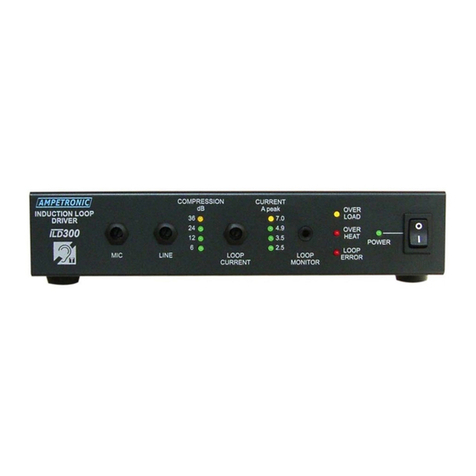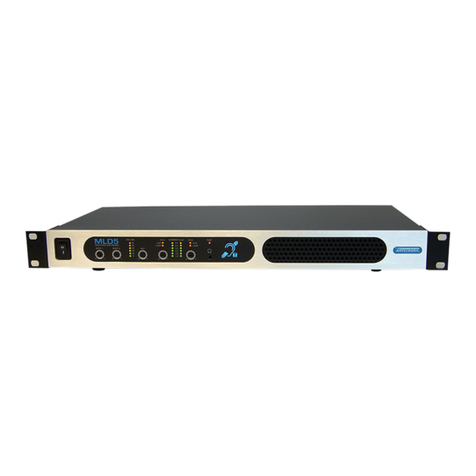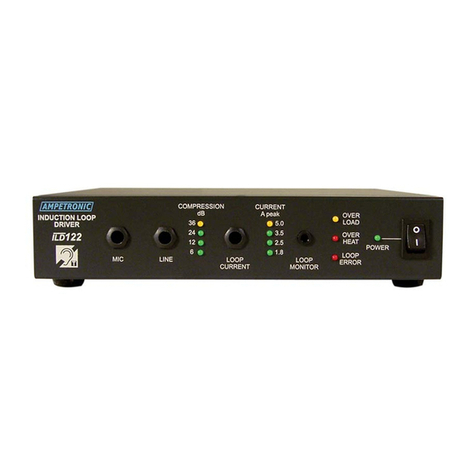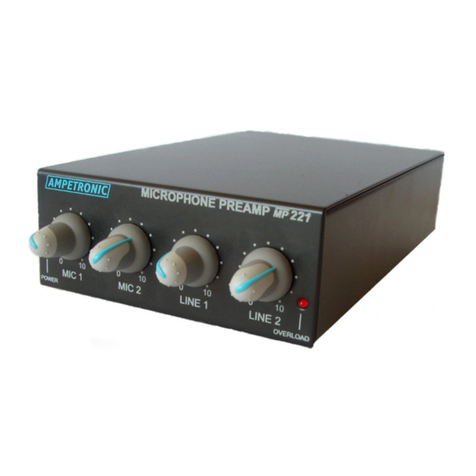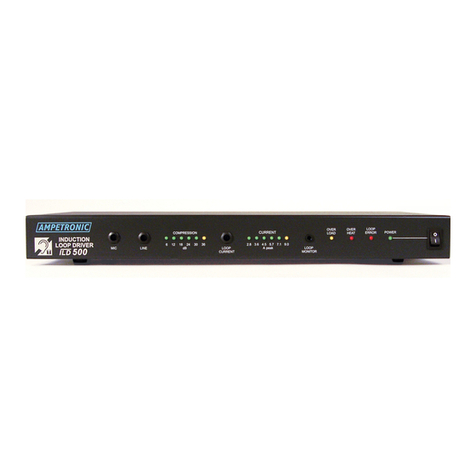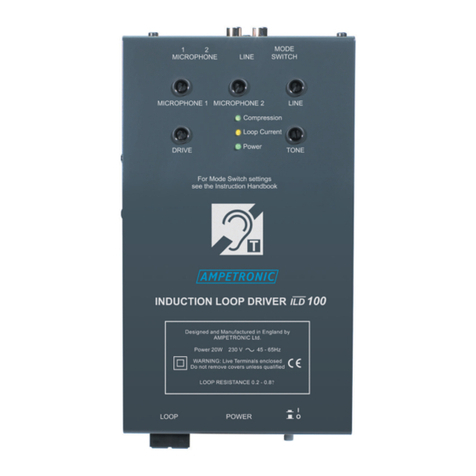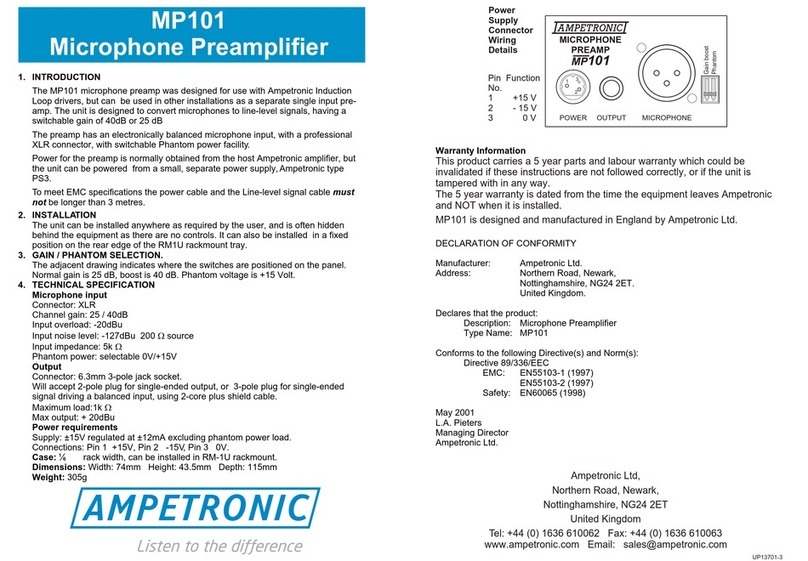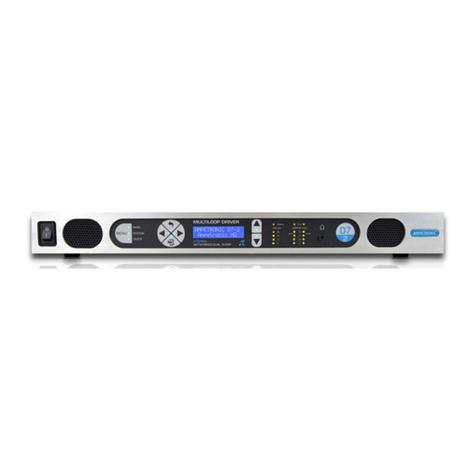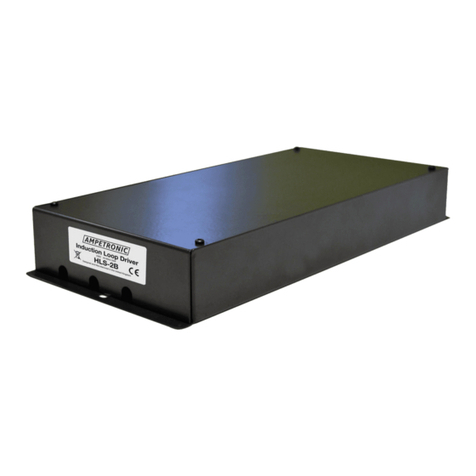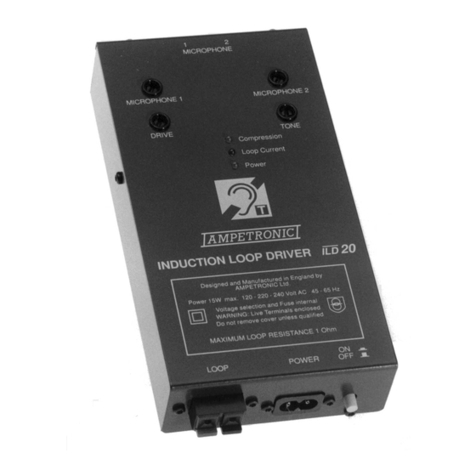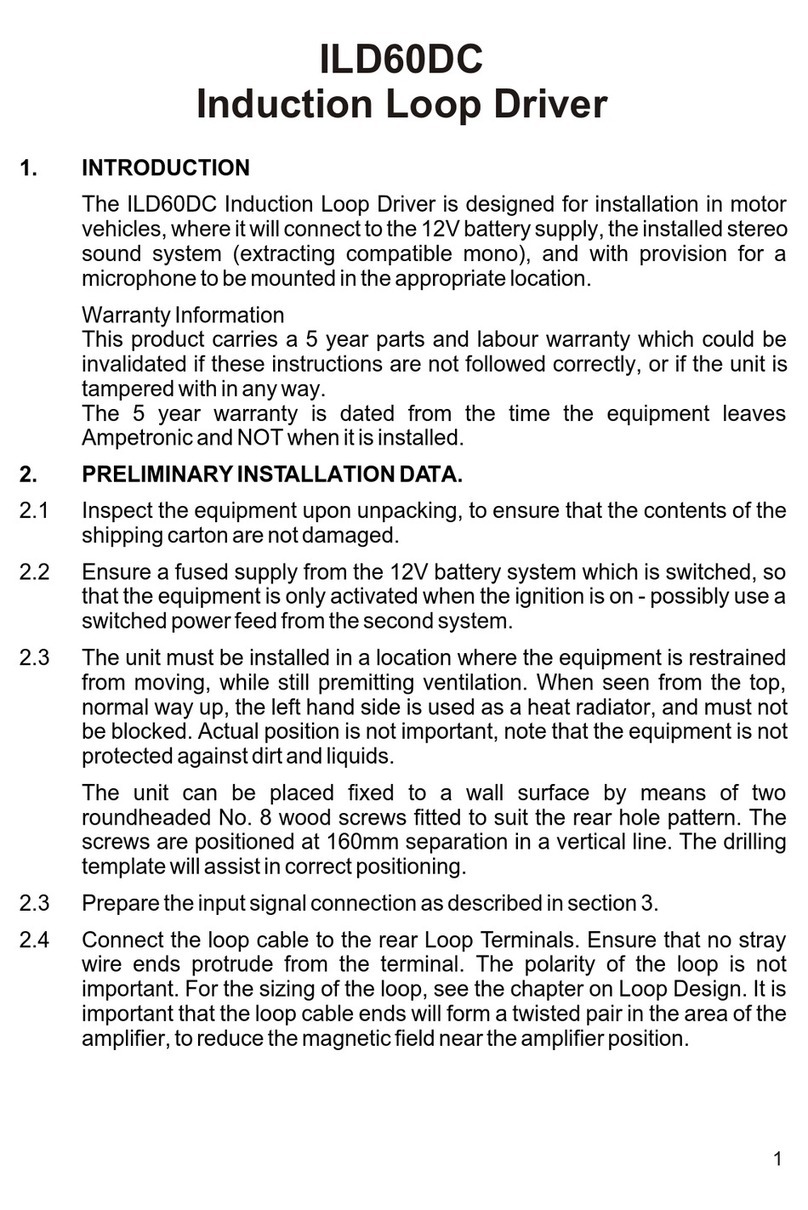
LOOP ERROR LED illuminated:
Indicates that the loop cable connected to the unit is outside specification.
Check that the loop cable is connected, terminated correctly and inserted into
the LOOP OUTPUT socket. Ensure the DC resistance is acceptable.
Low magnetic field strength:
Due to insufficient LOOP CURRENT or excessive metal loss.
May require a special loop design to achieve acceptable performance, contact
Ampetronic for advice.
Instability or high frequency noise
1) It is possible for the loop cable to become grounded under fault conditions,
resulting in instability which may sound like high frequency noise, buzz or
whistling. The results of this type of fault are unpredictable and may appear as
any combination of the front panel indication errors.
This fault is easy to determine: simply unplug the loop cable from the amplifier
and test with a resistance meter between either of the loop wires and a good
earth point such as a metal radiator. There should be an infinitely high reading
i.e. no connection at all. Any reading indicates a failure of the loop cable
insulation and you will need to either repair or replace the loop cable.
2) Instability can be caused by using poor quality signal cables, long
unbalanced (2-wire) signal runs to the inputs, or by running input cables in
close proximity with the loop wire over any appreciable distance. Loop
amplifiers are capable of delivering high currents at audio frequencies. If the
loop cable is run close to sensitive signal cables it may be possible to induce a
signal back into the input of the amplifier causing feedback. Cable runs and
loop wires should be kept well apart from each other. To avoid interference a
proximity of 300mm should only be run for a few meters. Always used
balanced (3-wire) circuits where possible.
3) Instability can cause the amplifier to run hot and may result in the
OVERHEAT LED illuminating. Always used balanced (3-wire) circuits where
possible.
If the loop is high resistance >5Ω - check all connections and re-tighten, there
may be something loose.
If the loop is low resistance <0.5Ω - check for short circuits in the loop connector.
²
If the loop is just very low resistance, fold a defined length (see below) of 0.5mm
cable in half and twist it together neatly – using a hand drill can be helpful. Coil this
loosely on the forearm and bind it so that it does not come un-coiled. Then connect
the two ends in series with the low resistance loop to ensure that the unit will
always turn on, but the system performance is un-affected. 5m of 0.5mm² wire will
add approximately 0.15 W to loop resistance. Use an appropriate length to ensure
the loop resistance exceeds 0.3W. Note: High or low resistance loops can be
encountered in a venue with a pre-installed loop, which was designed for use with
an old loop driver which might be being replaced. Before using this loop ensure
that the existing loop will allow the system to perform to an acceptable level by
checking it's layout details in the 'Designing Induction loops' handbook.
POWER LED not illuminated:
Check that the power (O / I) switch is toggled to the ON (I) position.
A 20mm fuse is incorporated in the AC POWER socket. It is necessary to
remove the power cord before extracting the fuse holder. Test the continuity of
the fuse using a multimeter. A spare fuse is provided in the fuse holder.
Any replacement fuse must be of the same fuse rating and type as
printed on the rear panel of the unit.
POWER LED flashing continuously:
Amplifier has failed self test and is in safe mode. No signal will be fed into the
loop. Switch the unit OFF, remove all connections except the loop and power
connections, turn all front panel controls to minimum and switch back ON. If
the problem persists, contact Ampetronic for advice.
COMPRESSION LEDs not illuminating:
Check input connections.
Ensure that the appropriate front panel control (Mic / Line) is turned up.
Check that there is sufficient signal level for the required input.
CURRENT LEDs not illuminating:
Check that the COMPRESSION LEDs are illuminating.
Check that the LOOP CURRENT control is turned up sufficiently.
Check that the LOOP ERROR, or OVERHEAT LEDs are not illuminated.
Ensure the POWER LED is illuminated and not flashing.
Remove any connection to the SLAVE I/O socket.
Check that the loop cable is connected, terminated correctly and inserted into
the LOOP OUTPUT socket.
Check the loop cable is not open circuit, short circuit, or connected to earth
(see Instability or high frequency noise section of Troubleshooting).
Note: You can listen to the actual loop signal by using a pair of headphones
plugged into the loop monitor socket.
OVERLOAD LED illuminated:
Indicates that too much current is being delivered into the loop.
Check that the COMPRESSION LEDs are illuminating.
Remove any connection to the SLAVE I/O socket.
Turn the LOOP CURRENT control down to avoid running too much current
into the loop.
Check the loop cable is not open circuit, short circuit, or connected to earth
(see Instability or high frequency noise section of Troubleshooting).
OVERHEAT LED illuminated:
Indicates that the internal heatsink is too hot. Loop current is not delivered.
Ensure that the unit is installed in a location with sufficient ventilation.Check
the loop cable is not open circuit, short circuit, or connected to earth (see
Instability or high frequency noise section of Troubleshooting).
TROUBLESHOOTING
